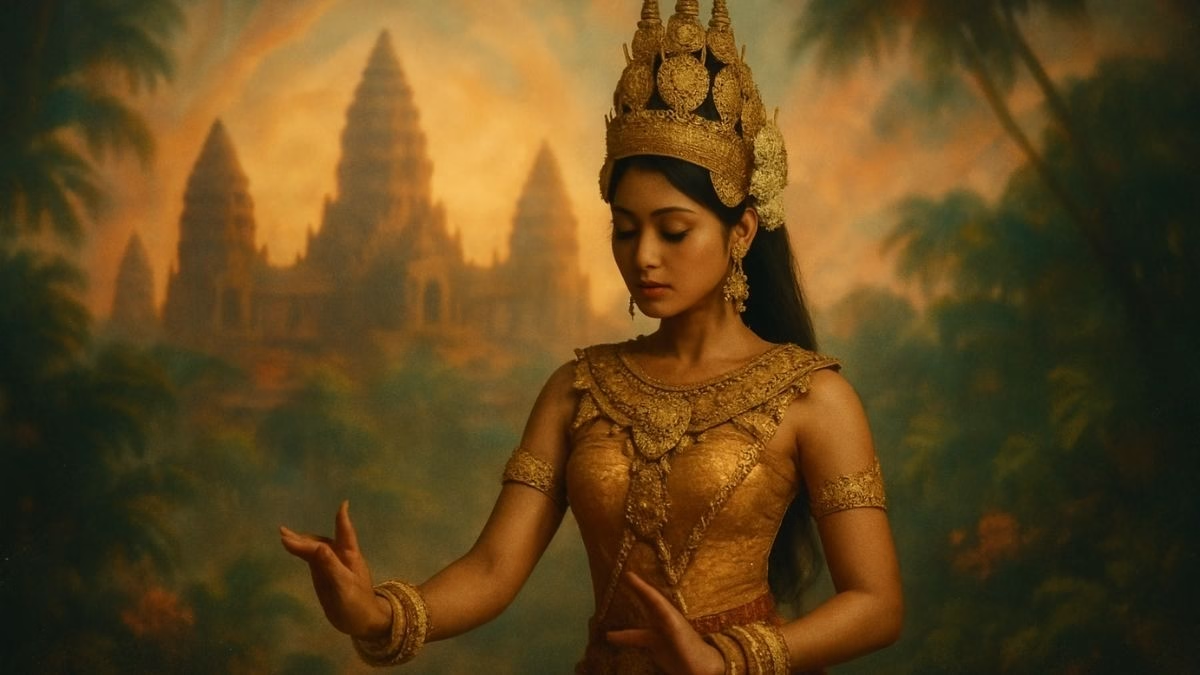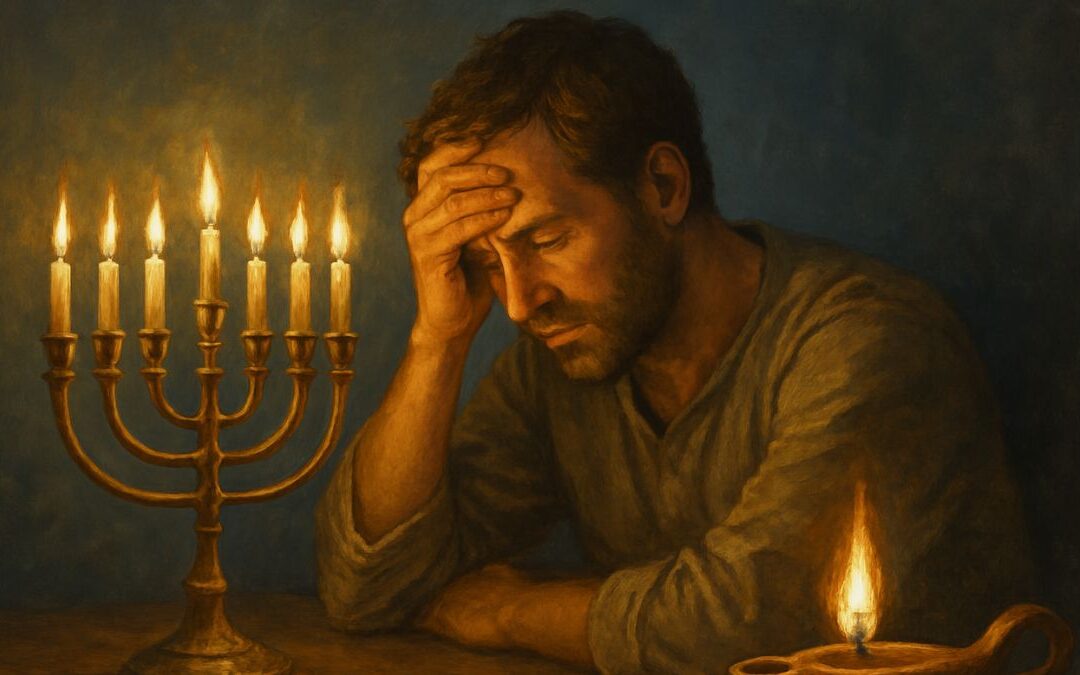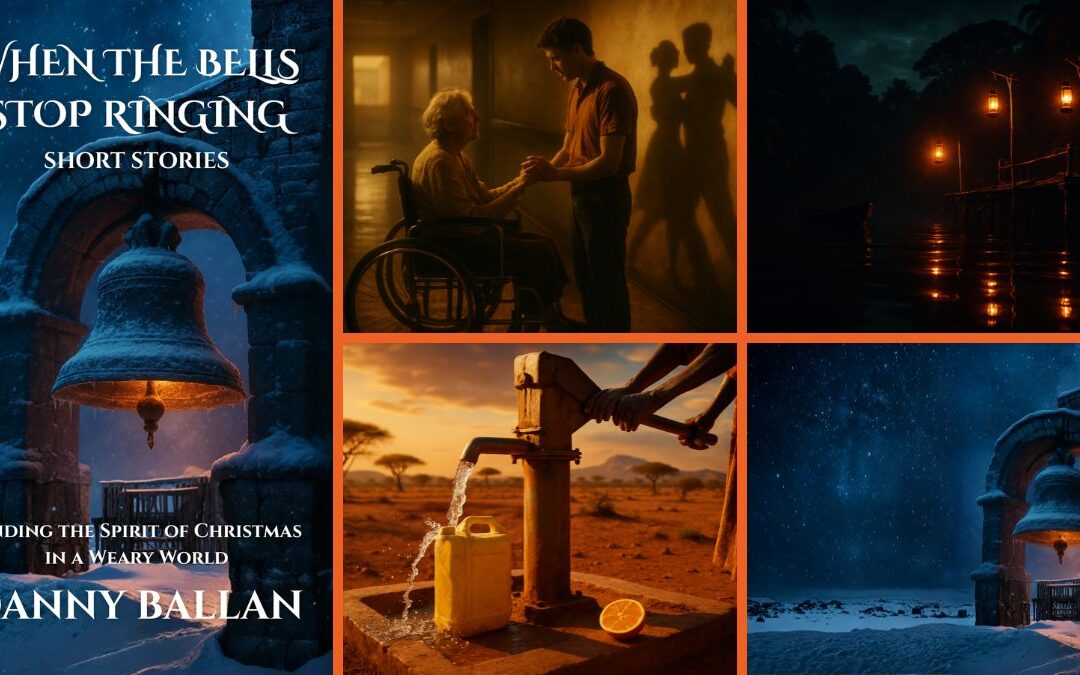- MagTalk Audio Discussion
- Whispers in Stone: The Enduring Grace of Cambodia’s Apsara Dance
- A Divine Origin: The Mythology Woven into the Dance
- The Grammar of Grace: Deconstructing the Apsara’s Language
- A Phoenix from the Ashes: The Dance’s Survival and Revival
- Focus on Language
- Let’s Discuss
- Learn with AI
- Let’s Play & Learn
MagTalk Audio Discussion
Cambodia’s Apsara Dance_ Myth, Resilience, and Living Grace Transcript
Cambodia’s Apsara Dance Myth, Resilience, and Living Grace
Imagine standing there, right? Among these huge ancient temples, thousands of silent carvings seem to almost vibrate with a hidden rhythm. What if that stone could actually dance? What if a whole art form was born from like a cosmic ocean, a mythic churning bringing forth this celestial beauty? And how could a dance possibly become a nation’s spirit, its unbreakable core surviving just unimaginable darkness? And how can every tiny hand gesture tell an epic story, without a single word? Welcome to a new Deep Dive from English Plus podcast. Today, we’re diving headfirst into the really mesmerizing world of the Apsara Dance of Cambodia.
And this isn’t just about looking at pretty pictures from history. No, not at all. Our goal here, our mission for this deep dive is to really get under the surface, to understand how this ancient art form, which yeah, at first glance seems frozen on those temple walls, how it’s actually a living breathing symbol, a symbol of incredible resilience of identity for the Cambodian people.
It’s this amazing connection, linking the modern commercial right back to its glorious ancient past. Okay, so where do we start? Picture yourself there, amidst those enormous vine covered temples of Angkor Wat. You can almost feel the weight of centuries, can’t you? The air feels thick with history, these whispers of a huge empire.
And literally everywhere you look, on lintels, gallery walls, you see them, thousands of unique Apsara carvings. Each one frozen in mid motion for a thousand years. These kind of enigmatic smiling celestial dancers.
It’s fascinating that how most people probably see them as just beautiful relics, right? Static pieces of the past. Exactly. But what’s truly mind blowing is that the Apsara Dance is anything but static.
It’s alive. It’s this profound vessel of identity for Cambodians, a tradition that has seen incredible royal splendor and then, well, the depths of near extinction. It’s like a prayer in motion, a story of defiance in every single graceful movement.
That’s it, yeah. So watching an Apsara Dance today, it’s more than just seeing a performance. It’s like witnessing a living bridge.
A bridge connecting modern Cambodia right back to those ancient roots. So we’re going to trace how these celestial dancers, supposedly born from a mythical ocean, were almost completely wiped out by violence and then somehow rose again. Rose to become this enduring symbol of a nation’s spirit.
It’s quite a story. And to really get the essence of it, we can’t just look at the steps, the choreography. We have to go back, way back.
To the mythology. To the mythology, yes. To the Hindu epics that had such a huge influence across Southeast Asia centuries ago, they became deeply woven into the Khmer culture, the dance’s roots.
They aren’t earthly, really. They’re celestial. Okay.
And this is where it gets really captivating. The whole art form comes from this Hindu myth, the Samudra Manthan. The churning of the ocean of milk, exactly.
It’s this epic cosmic story. You have the gods, the divas, and the demons, the Asuras. Right.
They actually call a truce to churn the cosmic ocean for a thousand years using the serpent king, Vivasuki, as the rope. Wow. And Matt Mandara as the churning stick, all to get the elixir of immortality.
And out of this cosmic churning? Came treasures. And among them, the Apsaras themselves. These incredibly beautiful female spirits, spirits of clouds and water, born fully formed, perfect.
And their whole purpose, to dance for the gods. So that story, that divine origin, that’s the bedrock. It’s the absolute spiritual bedrock.
Dancers today aren’t just playing a role. They’re seen as manifestations, embodying these celestial beings. Their purpose isn’t just entertainment.
It’s more profound. Much more. It’s about beautifying the world, being messengers between earth and heaven, embodying a kind of beauty so pure it could only be divine.
So thinking about that, if they see themselves as manifestations of these beings, does that change how the dancers approach it? Is there a spiritual side to the training beyond just the physical skill? Oh, absolutely. Massively. From their viewpoint, they’re not just learning steps.
They are striving to embody divinity, you know, seeking a kind of spiritual perfection through movement. It’s internal as much as external. And this deep connection, it moves straight from myth into the monarchy.
During the peak of the Angkorian Empire, that’s roughly the 9th to the 15th centuries, this mythology wasn’t just stories. It was state ideology. The king, the Devaraja or god king, was seen as divine on earth.
And the Apsara dancers fit into this how? They were central. They performed exclusively for the royal court, key figures in political and religious life. So the dance wasn’t just a show for the king.
It was ritual. Exactly. A sacred ritual, a living prayer that confirmed the king’s divine status.
It was about maintaining harmony, you know, between the human world and the cosmos. That paints such a clear picture of how art, power, and belief were all just tightly woven together. It really was a seamless tapestry.
And the dancers themselves, they were regarded as living treasures. Their training was incredibly rigorous, starting in early childhood. Dedicating their whole lives to it.
Their entire lives, yes, to perfecting this sacred art. They were the living embodiment of those carvings on the temples, a constant moving reminder of the empire’s divine connection. The dance literally held myth, religion, and royal power together.
Okay, so we have the myth, the royal court, the spiritual weight. Yeah. Now let’s get into the dance itself, this grammar of grace you mentioned.
It has this very slow, hypnotic feel, doesn’t it? It does. It looks almost otherworldly. But underneath that grace is immense control, incredible subtlety.
Every single gesture, every glance, it’s just loaded with meaning. So it looks beautiful, but it’s actually saying something. It’s a language, a complex, nuanced language, a grammar of grace.
As you said, it can tell epic stories, convey deep emotions, all without uttering a single word. And this language, its vocabulary, is built on four fundamental hand gestures. The Quebec.
Mastering these is step one, the absolute foundation. Okay, let’s break them down. What’s the first one? First is jib.
It literally means to pinch. You press the thumb and forefinger together, making this tiny, delicate pinch. Okay.
And what does that represent? It can be many things. A shy, unopened flower bud, maybe picking something up delicately. It’s all about subtlety, precision, quiet potential.
Got it. Jib. What’s next? Then there’s git, which means to fold.
This is where the hand bends way back from the wrist, often close to a 90-degree angle. Extreme flexibility. That hyper-extended look.
Very distinctive. Very. It’s one of the most iconic visuals.
It represents a blooming flower, perhaps, or a leaf unfurling. Growth. Revelation.
Okay. Jib, git. Number three.
Number three is long. The curve. Fingers and thumb make a soft, rounded shape.
Forefinger and thumb often touching. Like holding something round. Exactly.
It represents elegance, harmony. Could be the wholeness of a fruit or maybe the gentle curve of a naga serpent. Fluidity.
Perfection. And the last one. Finally, ban, meaning to break.
Here, the hand is flat, fingers straight, but the wrist flexes sharply down. That sounds like a contrast. It is.
It can convey strength or negation, like saying no or a sense of finality. It’s a definite punctuation mark compared to the flowing grace of the others. But it’s not just the hands doing the talking, right? The whole body.
The entire body tells the story. That distinctive stance, knees bent, feet arched. It gives this amazing sense of being both grounded and somehow floating.
Ethereal, though. Ethereal is a good word. The movements are never rushed.
Very deliberate, fluid. It creates this serene dignity. The back is arched, shoulders poised.
The head moves so delicately. And the eyes. The eyes convey so much longing, joy, sorrow.
Each pose is like a carefully built picture, a tableau. Frozen beauty that echoes those temple carvings perfectly. And the costumes.
We have to talk about the costumes. They’re just spectacular. Oh, completely.
The visual splendor is inseparable from the meaning. It’s an ornate tableau in itself. Silk, gold, jewels.
And every single element is steeped in symbolism. What are the key parts? Well, you have the tight-fitting silk bodice, usually heavily embroidered. Then the sandpot, that long decorative cloth wrapped like a skirt.
And often, fresh jasmine flowers woven in or worn as bracelets. Adding that scent, that fleeting element. Exactly.
But the most stunning part, the thing that just grabs you. The headdress. The mokhat.
That magnificent headdress, towering, spiral-like, gilded gold. It’s a direct visual link to the spires of Angkor Wat itself. And what does it symbolize? It symbolizes the sacred Mount Meru, the center of the Hindu-Buddhist cosmos.
So the dancer, spiritually speaking, is carrying the entire cosmos on her head. She embodies the axis of the universe. Wow.
That’s powerful. It is. And all the other adornments, the ornate earrings, necklaces, anklets, they’re not just pretty additions.
They’re part of this sacred uniform. Transforming the dancer from a mortal woman into a celestial being, a living apsara, bridging earth and heaven. Which brings us to this really dramatic pivot in the story.
Because the journey of the apsara dance in the 20th century is just one of unimaginable tragedy, and then almost miraculous rebirth. It really mirrors Cambodia’s own story, doesn’t it? It’s an incredibly painful chapter. When the Khmer Rouge took power in 1975, their goal was obliteration, wiping out the past, creating this forced agrarian society.
And artists were targets. Anyone associated with the old culture, intellectuals, artists, classical arts with those royal and religious links were especially targeted. It’s estimated that something like 90 percent of Cambodia’s dancers and artists were murdered.
Or died from starvation over work. 90 percent. 90 percent.
The apsara dance, this art form, passed down master to student for a thousand years. It was effectively silenced, just like that. The living connection to the past was severed, broken.
It’s almost impossible to wrap your head around that kind of deliberate destruction of cultural memory. It is. And after the regime fell in 1979, Cambodia was in ruins.
Its cultural memory almost erased. But somehow, a handful of master dancers survived. Against all odds.
Against all odds. And these survivors, they became keepers of the flame. Precious human libraries holding the entire tradition in their bodies, in their minds.
And Princess Norodom Bufidevi was key, wasn’t she? Hugely important. A revered prima ballerina of the royal ballet. Luckily, she was out of the country when the Khmer Rouge took over.
She, along with a few other surviving masters, began this monumental task. Reviving the art form. How did they even start? Imagine.
Stories of her teaching maybe one elderly student for hours, just trying to recall one forgotten hand gesture. Relying purely on muscle memory. Faint echoes of music.
It wasn’t just dance training. It was like national memory retrieval. A defiant act of reclaiming who they were.
So painstaking. Rebuilding it piece by piece. From almost nothing.
Reconstructing intricate choreographies, music, gestures, often purely from memory. They taught in refugee camps, in bombed out theaters, eventually back at the re-established Royal University of Fine Arts in Phnom Penh. It sounds like an act of sheer defiance.
Cultural, spiritual defiance. Absolutely. An assertion that their spirit could not, would not be broken.
And today, how is the Apsara dance doing? Today it’s really experiencing this incredible resplendent rebirth. It’s taught in schools again. Performed for visitors in places like Siem Reap.
Celebrated as the absolute crown jewel of Cambodian culture. And it got international recognition too, right? Yes. In 2003, the Royal Ballet of Cambodia, which includes the Apsara dance, was declared a UNESCO masterpiece of the oral and intangible heritage of humanity, recognizing its global importance and its unbelievable journey.
Because it really has become more than just an art form, hasn’t it? It’s this powerful living symbol of Cambodian resilience. Every single performance feels like a victory. A victory over the forces that tried to destroy it.
Every graceful movement is a tribute to the masters who were lost and to those few who kept the flame alive, ensuring the legacy survived. So seeing the Apsara dance today, it’s witnessing resilience made beautiful. Proof that even after the absolute darkest nights, beauty can find its way back.
That a culture’s soul can’t truly be extinguished. Those whispers in the stone at Angkor Wat, they found their voice again. Not in words, but in the enduring ethereal grace of the dance.
It really makes you think, doesn’t it? How preserving an art form, something seemingly intangible like a dance, can be such a profound act of national identity. An act of defiance, even. For any nation, really.
What intangible cultural heritage do we all hold on to, maybe without even realizing it, that defines who we are? It’s a powerful thought. And this was another deep dive from English Plus Podcast. Don’t forget to check out the full article on our website, englishpluspodcast.com, for more details, including the focus on language section and the activity section.
Thank you for listening. Stay curious and never stop learning. We’ll see you in the next episode.
Whispers in Stone: The Enduring Grace of Cambodia’s Apsara Dance
Stand amidst the colossal, vine-choked temples of Angkor Wat, and you will feel the weight of centuries. The air itself seems thick with history, with the ghosts of a once-mighty empire. And as you trace your fingers over the cool, gray sandstone, you will see them. Everywhere. Carved into the lintels, smiling enigmatically from the gallery walls, frozen in mid-motion for a thousand years—the Apsaras. Thousands of celestial dancers, each unique, each a silent testament to a culture that prized beauty and grace as a form of divine communion.
For most visitors, these carvings are a beautiful but static relic of the past. But what if the stone could speak? What if it could move? The truth is, it does. The Apsara dance is not just a memory etched in rock; it is a living, breathing art form, a vessel of identity for the Cambodian people. It is a tradition that has known the gilded splendor of royal courts and the abyssal darkness of near-annihilation.
To watch the Apsara dance today is to witness more than just a performance. It is to see a story of resilience made manifest, a prayer in motion, a living bridge connecting the modern Khmer soul to its glorious, ancient roots. This is the story of the celestial dancers who were born from a mythical ocean, were almost lost to a sea of violence, and rose again to become the enduring symbol of a nation’s unbreakable spirit.
A Divine Origin: The Mythology Woven into the Dance
To understand the Apsara dance, one cannot simply begin with its steps. One must go back to its mythological source, to the foundational Hindu epics that washed over Southeast Asia centuries ago and were absorbed into the Khmer cultural consciousness. The dance’s roots are not in the earth, but in the heavens.
Born from the Churning Ocean: The Myth of the Apsaras
According to the Hindu myth of the Samudra manthan, or the Churning of the Ocean of Milk, the gods (devas) and the demons (asuras) once formed a reluctant alliance. Their goal was to churn the cosmic ocean to obtain the elixir of immortality. As they churned the vast sea for a thousand years using a serpent king as a rope and a mountain as a churning dash, a host of celestial treasures emerged from the depths. Among them were the Apsaras, exquisitely beautiful female spirits of the clouds and waters, born fully formed and perfect, their sole purpose to dance for the gods.
This tale of divine origin is the spiritual bedrock of the Apsara dance. The dancers are not merely playing a role; they are seen as manifestations of these celestial beings. Their purpose is not simply to entertain, but to beautify the world and serve as messengers between the earthly and heavenly realms, embodying a beauty so pure it could only be of divine making.
The Living Bridge: From Celestial Beings to Royal Courts
During the zenith of the Angkorian Empire (roughly 9th to 15th centuries), this mythology was deeply integrated into the state’s ideology. The king, known as the devaraja or “god-king,” was considered a divine ruler on earth. The Apsara dancers, who performed exclusively for the royal court, were central to this political and religious life.
The dance was a sacred ritual, a form of kinetic prayer that affirmed the king’s divine status and maintained harmony between the human world and the cosmos. The dancers were living treasures, their training beginning in early childhood, their lives dedicated to perfecting this sacred art. They were the living embodiment of the carvings that adorned the temples, a constant, moving reminder of the empire’s divine mandate and celestial connection. The dance was the thread that wove together myth, religion, and royal power into a single, cohesive tapestry.
The Grammar of Grace: Deconstructing the Apsara’s Language
The Apsara dance is characterized by a slow, hypnotic, and almost otherworldly grace. It is a discipline of immense control and subtlety, where every gesture, every glance, is laden with meaning. To the untrained eye, it is a mesmerizing flow of movement. To the initiated, it is a complex and nuanced language, a “grammar of grace” capable of conveying epic stories and profound emotions without a single word being spoken.
The Four Gestures: A Coded Conversation
The entire vocabulary of the dance is built upon four fundamental hand gestures. The mastery of these gestures is the first and most critical step for any dancer.
- Jeeb (To Pinch): The thumb and forefinger are pressed together, creating a delicate pinch. This gesture can represent many things, from a shy, unopened flower to the act of picking something up. It is a gesture of subtlety and precision.
- Giet (To Fold): The hand is bent backward from the wrist with extreme flexibility, often at a near 90-degree angle. This hyper-extension of the wrist and fingers is one of the most iconic and difficult elements of the dance, representing the blooming of a flower or the unfurling of a leaf.
- Vong (The Curve): The fingers and thumb create a soft, rounded curve, with the forefinger and thumb often touching. This is a gesture of elegance and harmony, representing the wholeness of a fruit or the gentle curve of a naga serpent.
- Baen (To Break): The hand is held flat with the fingers straight, but the wrist is “broken” or flexed downward. This gesture can convey strength, negation, or a sense of finality.
These four gestures, combined in thousands of permutations, form a coded language that allows the dancer to narrate complex tales from the Reamker, the Cambodian version of the Ramayana epic.
A Story in Every Stance: The Meaning Behind the Poses
Beyond the hands, the entire body of the dancer tells a story. The distinctive stance, with knees bent and feet arched, creates a sense of both groundedness and ethereal lightness. The movements are never rushed; they are deliberate and fluid, creating a sense of serene dignity. The back is arched, the shoulders are held with poise, and the head moves with a delicate precision, the eyes casting glances that can convey longing, joy, or sorrow. Each pose is a carefully constructed tableau, a frozen moment of beauty that echoes the static grace of the temple carvings.
The Ornate Tableau: Costume and Symbolism
The visual splendor of the Apsara dance is inseparable from its meaning. The costume is an ornate tableau of silk, gold, and jewels, each element steeped in symbolism. The dancer wears a tight-fitting silk bodice, often intricately embroidered, and a sampot, a long piece of decorative fabric wrapped around the lower body like a skirt. Fresh jasmine flowers are often woven into the costume or worn as bracelets, adding a fragrant, ephemeral element to the performance.
The most striking feature is the magnificent headdress, the mokot. This towering, spire-like crown of gilded gold is a direct link to the spires of Angkor Wat, symbolizing the sacred Mount Meru, the center of the Hindu-Buddhist cosmos. The dancer is, quite literally, carrying the cosmos on her head. The ornate earrings, necklaces, and anklets are not mere decoration; they are part of a sacred uniform that transforms the dancer from a mortal woman into a celestial being.
A Phoenix from the Ashes: The Dance’s Survival and Revival
The story of the Apsara dance in the 20th century is one of unimaginable tragedy and almost miraculous rebirth. It is a story that mirrors the fate of the Cambodian nation itself.
The Darkness of the Khmer Rouge: A Near-Annihilation
When the brutal Khmer Rouge regime seized control of Cambodia in 1975, they sought to obliterate the nation’s past and create an agrarian dystopia. Intellectuals, artists, and anyone associated with the old culture were deemed enemies of the state. The classical arts, with their royal and religious associations, were a prime target. An estimated 90% of Cambodia’s dancers and artists were systematically murdered or died from starvation and overwork. The Apsara dance, an art form passed down from master to student for a millennium, was effectively silenced. The living link to the past was broken.
The Keepers of the Flame: Survival and Secret Teaching
After the fall of the Khmer Rouge in 1979, Cambodia was a nation in ruins. Its cultural memory had been all but erased. Yet, a handful of master dancers had, by some miracle, survived. These survivors became the keepers of the flame, the precious human libraries who held the entire tradition in their bodies and minds.
One of the most revered was Princess Norodom Buppha Devi, a prima ballerina of the Royal Ballet who had been out of the country when the Khmer Rouge took over. Along with the few other surviving masters, she began the monumental task of reviving the art form. They gathered the few surviving students, and painstakingly, from memory alone, they reconstructed the intricate choreographies, the music, and the gestures. They taught in refugee camps, in bombed-out theaters, and eventually, in the re-established Royal University of Fine Arts in Phnom Penh. It was an act of profound cultural and spiritual defiance.
A Resplendent Rebirth: The Apsara in Modern Cambodia
Today, the Apsara dance is undergoing a resplendent rebirth. It is taught in schools, performed for tourists in Siem Reap, and celebrated as the crown jewel of Cambodian culture. In 2003, the Royal Ballet of Cambodia, including the Apsara dance, was declared a UNESCO Masterpiece of the Oral and Intangible Heritage of Humanity, a recognition of its global significance.
The dance has become more than just an art form; it is a powerful symbol of Cambodian resilience. Each performance is a victory over the forces that sought to destroy it. Each graceful movement is a tribute to the masters who were lost and the keepers of the flame who ensured their legacy would not die.
To see the Apsara dance today is to see a testament to resilience—a testament to the idea that even after the darkest of nights, beauty can re-emerge, that a culture’s soul can never truly be extinguished. The whispers in the stone at Angkor Wat have once again found their voice, not in words, but in the enduring, ethereal grace of the dance.
Focus on Language
Vocabulary and Speaking
Let’s dive into the language that brought the story of the Apsara dance to life. When you’re talking about something as rich and layered as a thousand-year-old cultural tradition, the words you choose are everything. They can make the difference between a dry history lesson and a story that feels alive and full of meaning. We used some really evocative, metaphorical phrases to capture the magic and the weight of this topic, and I want to explore ten of them with you now. We’ll break them down, look at how they functioned in the article, and figure out how you can use them to make your own English sound more powerful and sophisticated.
Let’s start with the phrase vessel of identity. We said the Apsara dance is a “vessel of identity” for the Cambodian people. A vessel is a container, like a ship or a bowl, designed to hold something. So, a “vessel of identity” is not just a symbol; it’s a tradition, an art form, or even a language that contains and carries the core identity—the values, history, and spirit—of a group of people. It’s a powerful metaphor because it suggests that identity is something precious that needs to be held and protected. You can use this for many things. “For many immigrant communities, their native language is a crucial vessel of identity in a new country.” Or, “The family’s traditional holiday recipes are more than just food; they’re a vessel of identity, connecting them to their grandparents.”
Next up, we have divine origin. We used this to describe the dance’s mythological source. “Divine” means relating to a god or being god-like, and “origin” is the beginning or source of something. So, a divine origin is a beginning that is connected to the gods or a sacred story. It immediately elevates the subject, suggesting it’s not just man-made, but sacred and ancient. This phrase adds a sense of importance and mystique. You could use it to talk about historical concepts: “The ancient belief in the divine origin of kings gave them absolute authority.” Or you could use it more playfully: “My grandmother’s chocolate cake recipe is so good, I’m convinced it has a divine origin.” It’s a way of saying something is so special it seems to come from a higher place.
Let’s talk about the phrase living bridge. We called the dance a “living bridge” between the modern Khmer soul and its ancient roots. A bridge connects two separate places. A living bridge suggests that this connection is not a static, dead thing like a stone bridge, but something that is alive, dynamic, and actively maintained. It’s a beautiful way to describe how a tradition connects the present to the past. This metaphor is incredibly useful. You could say, “My grandfather is a living bridge to our family’s past; his stories keep our history alive.” Or in a business context, “Our long-time employees are a living bridge, passing down the company’s culture to new hires.”
Now for a phrase that really gets at the art form itself: grammar of grace. We used this to describe the complex language of the dance. “Grammar” is the set of rules that govern a language. So, a “grammar of grace” is a metaphorical way of saying that this beautiful, graceful dance isn’t random; it has a deep, underlying structure and a set of rules that allow it to communicate meaning. It suggests complexity and intelligence beneath the beauty. It’s a very elegant and sophisticated phrase. You could adapt it to other skills: “Watching the master chef work was incredible; he had a kind of grammar of flavor, knowing exactly how to combine ingredients.” Or, “She’s such a great public speaker, with a real grammar of persuasion.”
Let’s look at the phrase ornate tableau. We described the dancer’s costume as an “ornate tableau.” “Ornate” means elaborately or highly decorated. A “tableau” is a picturesque grouping of people or objects, like a living picture. So, an ornate tableau is a beautiful, detailed, and carefully arranged scene. We used it to capture the visual splendor of the costumed dancer, who looks like a living work of art. You can use this to describe any visually rich scene. “The wedding reception was an ornate tableau of flowers, candles, and elegantly dressed guests.” Or, “The museum’s diorama was an ornate tableau depicting life in ancient Rome.”
Let’s shift to the story of survival. We used the classic metaphor of a phoenix from the ashes. The phoenix is a mythical bird that is reborn from the ashes of its own funeral pyre. To be a “phoenix from the ashes” means to emerge renewed and triumphant from a catastrophe or a seemingly complete destruction. It’s a powerful symbol of rebirth and resilience. It’s a very common and useful idiom. “After the factory burned down, the owner’s determination to rebuild was inspiring; the new business truly became a phoenix from the ashes.” Or, “After her devastating illness, her return to championship form was a real phoenix-from-the-ashes story.”
Who helped this phoenix rise? The keepers of the flame. We called the surviving dance masters the “keepers of the flame.” The “flame” here is a metaphor for the tradition, the knowledge, the culture. The “keepers” are the people who protect it, keep it from being extinguished, and ensure it gets passed on. It’s a beautiful way to honor people who preserve something precious. You can use it to describe anyone who champions a cause or protects a legacy. “The librarians and archivists of the world are the keepers of the flame of human knowledge.” Or, “In our family, my aunt is the keeper of the flame, making sure we all remember our history.”
How did these keepers do it? The article says they did it painstakingly. This is a fantastic adverb. It means with great care and thoroughness. It contains the word “pain,” which suggests that the work is so meticulous and detailed that it’s almost painful. It implies a huge amount of effort and attention. It’s a great word to use when you want to emphasize how carefully something was done. “She painstakingly restored the antique chair, spending over a hundred hours on it.” Or, “The detective painstakingly pieced together the clues to solve the mystery.”
Next, we described the result as a resplendent rebirth. “Rebirth” is a revival or renaissance. The adjective “resplendent” means attractive and impressive through being richly colorful or sumptuous. It means shining, brilliant, dazzling. So a “resplendent rebirth” isn’t just a comeback; it’s a glorious, beautiful, and triumphant return. “After the renovation, the old theater enjoyed a resplendent rebirth, its lobby gleaming with gold leaf and velvet.” It’s a very strong and positive phrase for describing a successful revival.
Finally, we wrapped it all up by calling the dance a testament to resilience. A “testament” is something that serves as a sign or evidence of a specified fact or quality. So, a “testament to resilience” is a powerful piece of living proof of the ability to withstand or recover from difficult conditions. The dance’s very existence proves the resilience of the culture. This is a very useful and formal-sounding phrase for making a strong point. “His recovery and return to work is a testament to his incredible willpower.” Or, “This ancient building, having survived wars and earthquakes, is a testament to the skill of its builders.”
Now, let’s connect this to speaking. One of the key skills of any great storyteller is the ability to frame a narrative. You don’t just list facts; you shape them into a story with a clear theme. A powerful way to do this is by using what I’ll call “thematic phrases,” like the ones we’ve just discussed. Phrases like phoenix from the ashes or keepers of the flame aren’t just vocabulary; they are mini-stories in themselves. They provide a theme and an emotional arc.
When you’re telling a story, think about its core theme. Is it a story of survival? Of connection? Of meticulous work? Then, try to use a phrase that captures that theme. This will make your storytelling more focused and impactful.
Here is your challenge. I want you to think of a tradition that is important in your family, your community, or your culture. It could be a holiday celebration, a specific recipe, a type of music, or a local festival. Your assignment is to prepare a short, two-minute speech about why this tradition is important.
But here’s the catch: I want you to structure your story around one of the thematic phrases we’ve learned. Is your tradition a vessel of identity? Are the elders in your family the keepers of the flame? Is the story of its continuation a testament to resilience?
Start your speech by introducing this theme. For example: “In my family, our annual summer reunion is more than just a party; it’s a true testament to our resilience.” Then, tell the story of your tradition through that lens. Explain how it proves your family’s resilience. Try to use at least one other phrase from our list. Maybe someone painstakingly organizes it every year. Maybe it’s a living bridge to your ancestors.
Record yourself on your phone. The goal is to practice using these powerful, thematic phrases to give your storytelling a clear focus and a deeper emotional resonance. It’s a technique that will make your speaking more memorable and moving. Give it a try.
Grammar and Writing
Welcome to the grammar and writing workshop. We have journeyed into the heart of a beautiful and resilient culture, and we’ve armed ourselves with some wonderfully evocative language. Now, it’s time to put on our writer’s hat and translate that experience onto the page with a challenge designed to sharpen your descriptive and reflective writing skills.
Here is your writing challenge:
The Mission: The Travel Writer’s Sketch
Imagine you are a travel writer on assignment in Cambodia. You have just witnessed an Apsara dance performance for the first time. You are sitting in a quiet café, the hypnotic music still echoing in your ears, and you need to capture the experience in a 600-word descriptive essay or “sketch” for your magazine.
Your goal is not just to report what you saw, but to make your readers feel it. Your essay must:
- Paint a Vivid Picture: Describe the ornate tableau of the performance. Use sensory details to bring the dancers, the costumes, the music, and the atmosphere to life.
- Capture the “Grammar of Grace”: Don’t just say the dance was beautiful. Describe the quality of the movement. How did the dancers move? What was the feeling it evoked? Convey the slow, deliberate, and meaningful nature of the choreography.
- Connect to Deeper Meaning: Go beyond the surface. Reflect on the historical weight of the performance. How did it feel to watch this dance, knowing its history of near-annihilation and its resplendent rebirth? End your piece by reflecting on why this dance is more than just a performance; it’s a testament to resilience.
This is a challenge of observation and empathy, of translating a powerful non-verbal experience into compelling prose. To succeed, you’ll need to master a few key grammatical and stylistic tools.
Grammar Tool #1: The Power of Participial Phrases
One of the best ways to create rich, descriptive sentences is by using participial phrases. A participle is a verb form that can be used as an adjective (usually ending in -ing for the present participle or -ed/-en for the past participle). A participial phrase includes the participle and any modifiers or objects that go with it. They add dynamism and elegance to your writing.
- Instead of: “The dancer wore a golden headdress. She moved slowly across the stage.”
- Try: “Wearing a golden headdress, the dancer moved slowly across the stage.” (The phrase modifies “dancer”).
- Instead of: “The dance was passed down through generations. It carries the soul of a nation.”
- Try: “Passed down through generations, the dance carries the soul of a nation.” (The phrase modifies “dance”).
Your Mission: Use participial phrases to combine simple sentences and add descriptive flair. Challenge yourself to start at least three sentences in your essay with a participial phrase to vary your sentence structure. For example: “Shimmering under the stage lights…,” “Lost in the hypnotic rhythm…,” or “Carrying the weight of a thousand years…“
Grammar Tool #2: Using Appositives for Elegant Elaboration
An appositive is a noun or noun phrase that sits next to another noun to rename it or provide more information about it. It’s a fantastic way to tuck in details without interrupting the flow of your sentence with a new clause.
- Without Appositive: “The dancer wore a mokot. The mokot is a towering golden headdress.”
- With Appositive: “The dancer wore a mokot, a towering golden headdress, which shimmered under the lights.”
- Without Appositive: “We heard the music of the Pinpeat orchestra. The Pinpeat orchestra is the traditional ensemble that accompanies the dance.”
- With Appositive: “We heard the music of the Pinpeat orchestra, the traditional ensemble that accompanies the dance, its hypnotic rhythm filling the air.”
Pro-Tip: Use appositives to define key cultural terms (like mokot or sampot) smoothly and naturally, showing your reader that you’re a knowledgeable guide.
Writing Technique #1: “Show, Don’t Tell” with Sensory Verbs and Adverbs
The golden rule of descriptive writing is “Show, Don’t Tell.” Don’t just tell us the dance was graceful; show us how. The key is to use powerful, precise verbs and adverbs.
- Telling: “The dancer moved her hands nicely.”
- Showing: “The dancer’s fingers unfurled with painstaking slowness. Her hands arced through the air, wrists bending at impossible angles.”
- Telling: “The music was interesting.”
- Showing: “The xylophone’s notes tumbled over one another while a reedy oboe held a single, hauntingly long note.”
Brainstorm a list of verbs to describe movement (flow, arc, ripple, glide, unfurl) and adverbs to describe the quality of that movement (hypnotically, deliberately, serenely, painstakingly).
Writing Technique #2: The Zoom-In, Zoom-Out Method
A great descriptive essay moves between a wide-angle view and a close-up shot, just like a camera.
- Zoom Out (Establish the Scene): Start with the overall impression. Describe the stage, the audience, the collective feeling in the air. Set the ornate tableau.
- Example: “The entire stage was a wash of shimmering gold and crimson silk, a living painting brought to life against the velvet darkness.”
- Zoom In (Focus on a Detail): After setting the scene, zoom in on a single, powerful detail. This makes the description feel intimate and real.
- Example: “I found my eyes drawn to a single dancer’s hands. The fingers, adorned with golden rings, pinched together to represent a single, unopened jasmine bud, a gesture of profound and delicate potential.”
- Zoom Out (Connect to Meaning): After describing the detail, zoom back out to connect it to a larger idea or emotion. This is where you bring in the deeper meaning.
- Example: “In that one small gesture, a universe of patience and hope seemed to reside—the promise that even after a long winter, things can, and will, bloom again.”
By alternating between these perspectives, you create a dynamic rhythm for your reader and guide them from simple observation to profound reflection. This is how you show them that the Apsara dance is, truly, a testament to resilience.
Vocabulary Quiz
Let’s Discuss
Here are some questions designed to spark conversation about the deeper themes of the Apsara dance and its connection to culture everywhere. Share your own thoughts and experiences.
- The “Vessel of Identity”: The article describes the Apsara dance as a “vessel of national identity.” What are some traditions, art forms, foods, or even pieces of music from your own culture that you feel serve a similar role? What gives them this power to represent a whole group of people?
- Dive Deeper: Think about what makes these symbols so potent. Is it their age? Their connection to history? Their uniqueness? Discuss how these vessels of identity are passed down and what threats they might face in the modern world (e.g., commercialization, globalization, or simply being forgotten).
- The “Keepers of the Flame”: The story of the Apsara dance’s survival depended on a few “keepers of the flame.” Who are the keepers of the flame in your own community, family, or field of interest?
- Dive Deeper: These people don’t have to be famous. They could be a grandmother who teaches traditional recipes, a local librarian who archives town history, or a skilled artisan who takes on apprentices. What motivates these individuals? What challenges do they face, and how can a community better support its keepers of the flame?
- Preservation vs. Evolution: The Apsara dance was painstakingly reconstructed to be as authentic as possible. But is it possible for a tradition to be so focused on preservation that it stops evolving? Where is the right balance between honoring the past and allowing an art form to stay relevant and alive for new generations?
- Dive Deeper: Consider other art forms. Think of classical music versus modern pop, or traditional painting versus contemporary art. Can a tradition be changed too much? Who gets to decide what changes are acceptable? Is “authenticity” a fixed point in the past, or is it something that is constantly being redefined?
- Art as a “Testament to Resilience”: The Apsara dance is a powerful example of art surviving and triumphing over tragedy. Can you think of other examples of music, literature, or art that were created in response to or in defiance of great hardship?
- Dive Deeper: Why do humans so often turn to art in the darkest of times? What role does creativity play in healing, resistance, and remembrance? Discuss how a piece of art’s tragic backstory can change the way we experience it. Does it make it more powerful?
- The Tourist’s Gaze: Today, many people experience the Apsara dance as a tourist performance in a hotel or restaurant in Cambodia. What are the pros and cons of this? How does it feel to consume a sacred art form as entertainment?
- Dive Deeper: On one hand, tourism provides vital income that helps keep the art form alive and supports the artists. On the other hand, does it risk cheapening the dance or stripping it of its spiritual context? How can a traveler be a more responsible and respectful audience for such a culturally significant performance?
Learn with AI
Disclaimer:
Because we believe in the importance of using AI and all other technological advances in our learning journey, we have decided to add a section called Learn with AI to add yet another perspective to our learning and see if we can learn a thing or two from AI. We mainly use Open AI, but sometimes we try other models as well. We asked AI to read what we said so far about this topic and tell us, as an expert, about other things or perspectives we might have missed and this is what we got in response.
Hello everyone. As a cultural anthropologist who has spent a good deal of time studying the performance arts of Southeast Asia, I found the article to be a beautiful and moving introduction to the Apsara tradition. It wonderfully captures the dance’s mythology and its powerful story of survival. Now, I’d like to put on my specialist’s hat and add a few layers of detail that can enrich your understanding even further.
First, we simply cannot talk about the dance without talking about the music. The Apsara dance is inseparable from its musical accompaniment, which is provided by a traditional ensemble called the Pinpeat orchestra. If the dance is the body, the Pinpeat is the breath and the heartbeat. This orchestra is not just background music; it’s an active participant in the storytelling. It’s composed mainly of percussion instruments: several types of xylophones (roneat), circular sets of tuned gongs (kong thom), and drums (skor thom), all anchored by a piercing, quadruple-reed oboe called the sralai. The music is cyclical and hypnotic, and the dancers are trained to embody its rhythms. The tempo and melody signal emotional shifts and narrative cues. To watch the dance without understanding the role of the Pinpeat is to see only half the picture.
Second, the article rightly focused on the iconic female Apsara role, but it’s important to know this is part of a much larger repertoire of Cambodian classical dance. There are also distinct male roles. The male counterpart to the serene Apsara is the Tep Monorom, a dance for a male “deva” or god, which is more forceful and athletic. Furthermore, within the dance dramas, you have powerful masked male characters. The most famous is the white-masked monkey general, Hanuman. His movements are acrobatic and mischievous, a complete contrast to the slow grace of the Apsaras. So, a full performance of a story like the Reamker is a rich tapestry of different character types and dance styles, showcasing a wide range of masculine and feminine energy.
Third, while the art form was standardized by the Royal Ballet, there can be subtle regional variations or differences between schools of dance. Think of it like dialects in a language. The core grammar is the same, but the “accent” can change. One school might emphasize a slightly different posture, a more pronounced hand gesture, or have a unique variation in a piece of costume. These distinctions are often subtle to an outsider’s eye but are a source of identity and pride for the artists themselves. This highlights that “culture” isn’t a single, monolithic thing, but is alive with nuance and local flavor.
Finally, we must touch upon the politics of culture. The Apsara dance today is a powerful symbol of the Cambodian nation, and as such, it’s used on the national and international stage. The government promotes it heavily, and it’s a cornerstone of the tourism industry. This is wonderful for its visibility and for the financial support it provides artists. However, this raises complex questions about the line between preservation and commercialization. When a sacred court ritual is performed nightly for tourists over dinner, does its meaning change? This is a tension that exists with traditional arts all over the world. There’s no easy answer, but it’s crucial to recognize that these beautiful art forms don’t exist in a vacuum. They are deeply embedded in the social, political, and economic realities of their time.
Considering these elements—the music, the other character roles, the regional nuances, and the modern context—gives us an even more complete and fascinating picture of this truly remarkable art form.










0 Comments